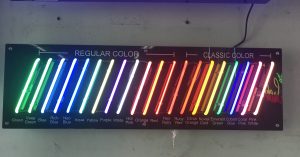Do Neon Signs Use A lot of Energy?

Aiming for a striking storefront sign comes easy today with a wide range of available products for every purpose. Neon signs are still in the top spot for the best options of lighting fixtures. They are easy to maintain and can stand being lit all night long.
The cost of neon signs varies based on their sizes. Larger signs could cost you more as you add more letters to the signage. Now if you’re concern lies in its level of energy consumption, then there’s good news coming your way.

How much power does a neon sign use?
A red neon light’s typical energy consumption is at 3 1/2 to 4 watts per foot. If you have a business that needs your signages to attract customers till dawn, neon lights offer competent numbers than fluorescent models.
If you continuously run a sign for 12 hours, a foot of red neon sign would typically use about 15.33 to 17.52-kilowatt-hours of electricity per year while a fluorescent model will take up 50 percent more than that. These figures might not seem much at first, but if you count the annual rates, then there’s the real deal.
Are neon lights still the best as storefront sign?
As of 2019, the cost of energy per kilowatt-hour is $.12.
Considering the numbers above, you’d have to pay $320 per year to run a fluorescent sign and $210 per year to run a neon sign.
Neon signs offer efficient power consumption advantages to their users. It uses less power, and when you calculate the rates, neon signs can be one of the cheapest options you have for that lit storefront you want.
Neon Lights Compared to LED
Light-emitting diodes are said to offer more efficient energy consumption compared to neon tubes. This comparison between LED and neon signs claim that the former offer 90% more energy savings.
The problem with these claims is that they fail to consider the relative energy inefficiency of LED light sources compared to neon signs.
Yes, LED lights bearing the same color and size as neon light may consume less power. But a foot of LED tube lighting that’s left on for 12 consecutive hours per day may consume energy as low as 3.5 kWh per year. Yet, the light put out by the LED tube won’t be as bright as the neon tube.
When we adjust the LED brightness to be at par with neon signs, the difference in their energy consumption won’t be that far. So if you’re a store owner who wants the brightest signage to attract customers, neon might still be the best option.
Neon Light Compared to Fluorescent and Incandescent
Neon signs offer more efficient energy consumption than fluorescent bulbs.
A fluorescent fixture may consume up to 50% more energy than neon glass tubes. Also, high output fluorescent lights tend to rack up more energy costs. For example, one foot of HO fluorescent tube consumes up to 70 kWh per year when left lighting for 12 hours a day.
The contrast in the power draw between a neon fixture and an incandescent bulb is even greater. The latter consumes up to four times as much power as similar fluorescent bulbs.
Neon Lights Alternatives
The gap between neon lighting and LED signs when it comes to their electricity consumption might not be that wide.
LED lights offer other advantages that make them an amazing choice against neon signs glass tubing.
Also, LED lights demand virtually zero maintenance. There are no gases that need extra care, no mercury problems, and no glass tubes. They also produce almost zero heat while burning bright.
You can even find an LED neon sign almost everywhere that mimics the look of neon signs. It’s almost impossible to tell the difference from each other. A LED signage also tends to be durable and long-lasting since they are resistant to humidity and water. This technology is one of the best options if you want to have an alternative to the traditional neon sign.
Conclusion
Neon lighting is still the most attractive option for colorful signage. They offer efficient power draw without compromising their glow. This quality is the reason why fluorescent and incandescent lighting options aren’t the first choice for many business owners. That’s the reason why most storefronts in the United States still use traditional neon signs.
If you want control over your overall energy costs, it’s advisable that you schedule turning on the neon signs only during peak hours. Besides, it’s not highly encouraged to let your neon glass tubes burn for consecutive nights. Doing so may compromise the glow of the neon gas and the overall durability of the sign. This also rings true to any fluorescent sign and LED neon signs.
If you want a fantastic storefront that may result in better customer turnaround, then neon lighting is the way to be.
Are you ready to pick your first traditional neon business sign? Then take a look at our series of neon signs and LED neon signs here.
NEON SIGN
- Latest News
- Testimonies
- Help Centre
- Delivery Information
- Returns Policy

- About Us
- Gallery
- Terms and Policy
- Terms and Conditions
- Blogs
- Support
- Contact Us
- FAQ
- LIVE CHAT Online Now

Stay Connected and Get Updates
The Gravity Forms plugin is not activated